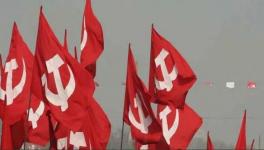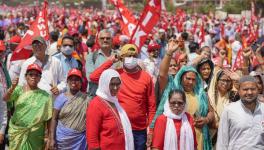A Frontal Attack on Labour in the Shadow of Hindutva

The class function of Hindutva is becoming clearer by the day. In the lee of Hindutva, the Modi government is embarking on a massive programme of privatisation of the public sector, and of attack on the working class. Such a programme could not have been launched under the “normal” circumstances of bourgeois rule; it would have aroused stiff opposition. But the government feels emboldened to attempt it when the nation is being divided in the name of Hindutva, when the combination of fear of the “other”, and hatred in consequence of it, are being inculcated among the majority.
Fear creates the need for a “saviour”; and if the so-called “saviour” is also doing the privatisation, then people are less strident in their opposition to it. They are too distracted by the Hindutva discourse to mount any challenge to the class agenda of the corporate-financial oligarchy in which such privatisation figures prominently. Hindutva, in short, brings about a discourse shift that works in the interests of the corporate-financial oligarchy.
Privatisation is being introduced in diverse ways. Some public sector enterprises are earmarked for outright sale, not just loss-making ones, but even those which make handsome profits. In others, the government intends to reduce its own share of equity below 51% through disinvestment. In still others, the idea is to break up the total activity into several different individual activities and to privatise some individual activities by divesting the public sector of those; this last route is what is being followed with regard to the Railways.
In addition to these ways of privatising the existing public sector, there is also an effort to bypass the public sector where it exists, to reduce its scope as much as possible. In a sphere like coal mining, which had been hitherto kept more or less exclusively for the public sector, even foreign capital is now being invited to participate. In railway components, such as locomotives, imports from foreign firms are being resorted to, and domestic production in the public sector is being correspondingly curtailed; this is but a prelude to running down the public sector units to extinction.
Likewise, legislation to “reform” existing labour laws that would make the sacking of workers easier, is likely to be introduced in the coming Lok Sabha session. In fact, only about 4% of the total workforce in the country is covered by whatever protection the existing labour laws provide, since even in the “organised sector”, casualisation of the workforce has proceeded remarkably fast; the real objective of the proposed change in labour laws, therefore, is to make trade unions impossible, since anyone unionising the workers would be sacked forthwith.
Privatising the public sector will have an exactly similar consequence. All over the world, workers in the private sector are less unionised than in the public sector. In the US, for instance, while only about 7% of private sector workers are unionised, the corresponding ratio in the public sector (including education) is 33%. The shift of a unit from the domain of the public sector to that of the private sector, therefore, will have a deleterious effect on unionisation.
The Narendra Modi government’s real objective, therefore, is a frontal attack on the working class, something which the corporate-financial oligarchy would dearly love, but which had not been easy to launch earlier. In the shadow of Hindutva this is being sought to be achieved.
The corporate gain in the shadow of Hindutva is by no means accidental. In fact, the economic ideology of the votaries of Hindutva is unblinkingly and unashamedly pro-corporate. This fact was expressed in the clearest possible terms by Modi himself when he said that the capitalists were the “wealth creators” for the country, which even bourgeois economics would not claim.
Standard textbooks of bourgeois economics mention four “factors of production” -- land, labour, capital, and enterprise -- as coming together to undertake production, upon which the creation of wealth depends. This eclecticism on their part is suggestive of the fact that they want to show capital which the capitalists “contribute” as being no less important than labour in the process of wealth creation: the capitalists, in other words, far from being exploiters, as the socialists argue, are co-contributors to the creation of wealth.
The Hindu Right, however, has gone even further than standard bourgeois textbooks. It has eliminated labour completely from the list of wealth creators. It sees the capitalists not just as co-contributors alongside labour to the process of wealth creation, as bourgeois textbooks do; it sees them as the lone creators of wealth. A more craven apologia for the capitalists, and hence in today’s world for the corporates, can scarcely be imagined.
In fact, going beyond bourgeois textbooks, we can say that human labour acting upon nature is the source of all things, or use-values. Some of these things are used in the process of man’s acting upon nature, as instruments of labour (capital stock). A group of persons, namely, the capitalists, make themselves the owners of these instruments of labour and, therefore, claim a part of the things produced without performing any labour themselves. They consume a part of what they appropriate, and use the other part to add to the stock of instruments of labour.
Let us, generously, interpret Modi as lauding the capitalists because they add to the stock of instruments of labour. Even then, to call them “wealth-creators”, because they do not consume everything they appropriate but also add to the instruments of labour, is to show complete ignorance of this total process.
Even greater ignorance is displayed by Modi in his remark that the tax concession amounting to Rs1.45 lakh crore, which his government has just given to the corporates, is for the benefit of all; it represents, he claims, a “win-win situation” for 120 crore Indians!
Here Modi has gone even beyond his own view of capitalists being “wealth creators”. Even if corproates simply hoard the entire Rs 1.45 lakh crore without adding an iota to the stock of instruments of labour (which incidentally would produce massive unemployment because of a reduction in aggregate demand), even then it apparently constitutes a “win-win situation”!
It is clear that the Hindutva view of economics is a simple one: the more money is handed over to the corporates, the better it is for society. The limit to what can be handed over, however, is set by what must be given to the working people; hence, the Hindutva view would suggest that the less given to the working people, the better it is for society! The Hindutva view, in short, is not just anti-minority, anti-dalit, anti-tribal, anti-women, as is well-known; it is essentially and fundamentally anti-working people as well.
There is a vicious dialectic at work here. Hindutva’s solution to the economic crisis currently engulfing the country is to further increase the amount of money in the hands of corporates; in fact, given its economics, it can have no other conception. To do this, however, it will have to bring about an even more aggressive discourse shift, by engaging in even more “shock and awe” operations, like “one nation-one-language”, the National Register of Citizens, and the Citizenship Amendment Bill. Each of these will have a devastating effect on the lives of the people and the unity of the nation.
But additionally, since putting more money into the hands of the corporates, far from overcoming the crisis, will only have the effect of worsening it, the Hindutva government, instead of desisting from such dangerous measures, will only intensify them further. In other words, as the crisis deepens, and as the pro-corporate measures escalate in a futile bid to alleviate it, the communal assault on the hapless minorities, will also escalate.
While the Hindutva-corporate axis, which is built around this particular class understanding imbibed by Hindutva, unleashes this vicious dialectic, its Achilles heel consists in the fact that through this dialectic the crisis will only intensify, ultimately calling forth resistance that will overwhelm it.
Get the latest reports & analysis with people's perspective on Protests, movements & deep analytical videos, discussions of the current affairs in your Telegram app. Subscribe to NewsClick's Telegram channel & get Real-Time updates on stories, as they get published on our website.
























